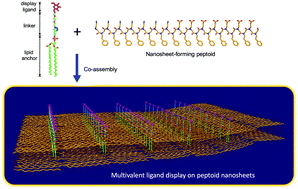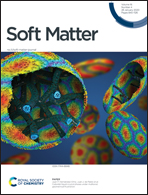Lipid-anchor display on peptoid nanosheets via co-assembly for multivalent pathogen recognition†
Abstract
Biological systems have evolved sophisticated molecular assemblies capable of exquisite molecular recognition across length scales ranging from angstroms to microns. For instance, the self-organization of glycolipids and glycoproteins on cell membranes allows for molecular recognition of a diversity of ligands ranging from small molecules and proteins to viruses and whole cells. A distinguishing feature of these 2D surfaces is they achieve exceptional binding selectivity and avidity by exploiting multivalent binding interactions. Here we develop a 2D ligand display platform based on peptoid nanosheets that mimics the structure and function of the cell membrane. A variety of small-molecule lipid-conjugates were co-assembled with the peptoid chains to create a diversity of functionalized nanosheet bilayers with varying display densities. The functional heads of the lipids were shown to be surface-exposed, and the carbon tails immobilized into the hydrophobic interior. We demonstrate that saccharide-functionalized nanosheets (e.g., made from globotriaosylsphingosine or 1,2-dipalmitoyl-sn-glycero-3-phospho((ethyl-1′,2′,3′-triazole)triethyleneglycolmannose)) can have very diverse binding properties, exhibiting specific binding to multivalent proteins as well as to intact bacterial cells. Analysis of sugar display densities revealed that Shiga toxin 1 subunit B (a pentameric protein) and FimH-expressing Escherichia coli (E. coli) bind through the cooperative binding behavior of multiple carbohydrates. The ability to readily incorporate and display a wide variety of lipidated cargo on the surface of peptoid nanosheets makes this a convenient route to soluble, cell-surface mimetic materials. These materials hold great promise for drug screening, biosensing, bioremediation, and as a means to combat pathogens by direct physical binding through a well-defined, multivalent 2D material.



 Please wait while we load your content...
Please wait while we load your content...